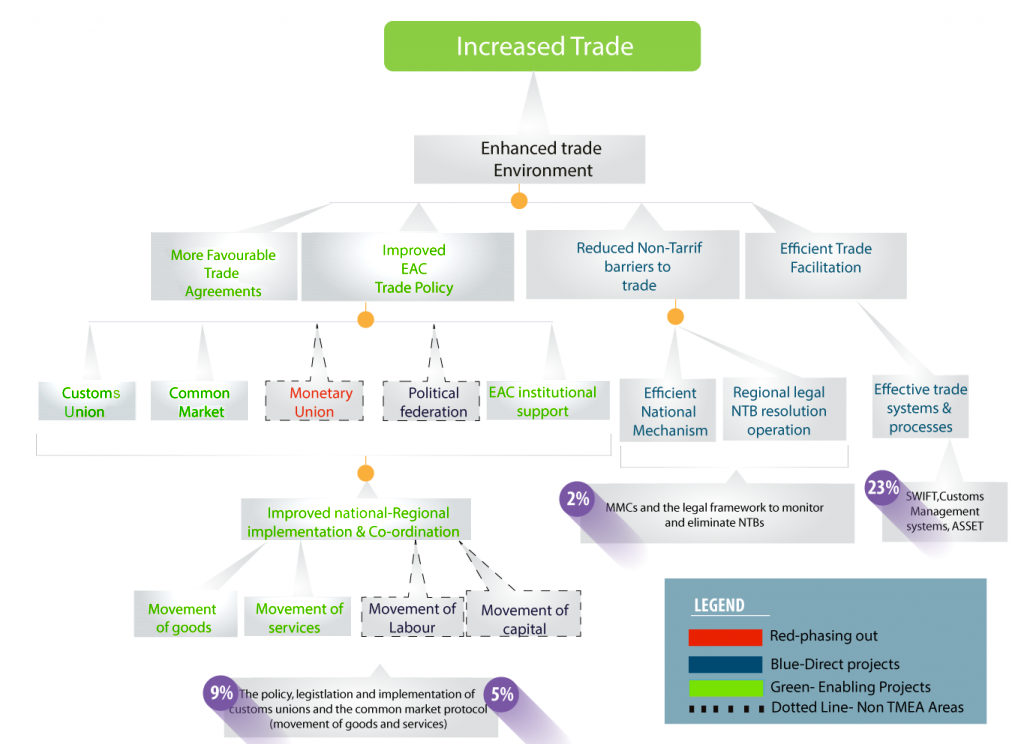
Our Projects are
Transforming African Trade
Quick Contacts
2nd Floor, Fidelity Insurance Centre Waiyaki Way, Westlands
Diagram: Enhanced Trade Environment logic and budget allocations

TradeMark Africa (TMA) believes that trade policies and their implementation can contribute to enhancing the environment for trade within East Africa. In particular, the implementation of the East African Community regional trade agreements will contribute to increasing the region’s competitiveness by increasing the size of the market and making the region more open. The implementation of regional trade agreements is also expected to contribute to reducing trade costs if harmonised policies, legislation and procedures are used throughout East Africa.
In particular, TradeMark Africa (TMA) believes that the full implementation of the Customs Union is a critical step to enhancing the trade environment. Without full implementation of the Customs Union, the implementation of the Common Market Protocol and subsequent protocols, yet to be negotiated, will be unable to take effect.
The logic above is underpinned by a number of assumptions. These include:
i. Implementing the EAC regional trade agreements will contribute to enhancing the trade environment in the region.
ii. There is sufficient demand by partner state parliaments, public sector, private sector and civil society organisations to drive the regional economic community agenda forward.
iii. Regional trade policies will be prioritised by partner states over national trade policies and priorities.
It is expected that the logic will be further developed and expanded during the process of designing the Single Customs Territory and Trade in Services projects.
| STRATEGIC OUTCOME | EXAMPLES OF CONTRIBUTING PROJECTS | EXAMPLES OF THE TYPE OF CONTRIBUTION EXPECTED (END OF PROJECT OUTCOMES) |
|---|---|---|
| Enhanced Trade Environment – implementation of the Customs Union | Implementation of the Single Customs Territory high-level task force action plan
Total number: 6 |
EAC Partner States commence implementation of the revenue sharing agreement; EAC Partners States implement OSBP legislation and procedures |
| Enhanced Trade Environment – implementation of the CMP goods | Upgrading regional customs management training programmes; IBM
Total number: 8 |
Border agencies consistently use joint working procedures at selected borders |
| Enhanced Trade Environment – implementation of the CMP services | Tourism platform advocacy, Professional services platform advocacy.
Total number: 6 |
EAC partner states implement a single tourist visa; EAC partner states recognise professionals from East Africa |
| Enhanced Trade Environment – improved regional and national coordination | EAC Secretariat, MEAC and MDA capacity development programme, Northern and Central corridor transport observatories
Total number: 41 |
MEACs improve strategic leadership and coordination of EAC integration; EA corridor authorities increase the availability of corridor performance information |
| Enhanced Trade Environment – Reduced Non-Tariff Barriers to Trade | Operationalisation of NTB national monitoring committees | NTB NMCs increase the removal of NTBs across the region |
| Enhanced Trade Environment – Efficient Trade Systems and Procedures | Single window projects support to customs systems in Revenue Authorities | Agencies improve efficiency in processing and clearance of trade-related documentation. |